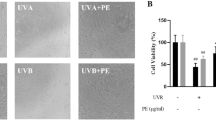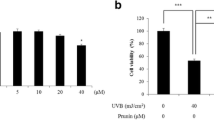Abstract
Inappropriate apoptosis results in the epidermal hyperplasia as in psoriasis and UVB irradiation has been successfully used to treat this kind of skin disorders. Previously, we reported that the novel phytosphingosine derivative, tetraacetyl phytosphingosine (TAPS) induced apoptosis in HaCaT cells. This study examined the effect of UVB irradiation and/or TAPS on the induction of apoptosis in HaCaT. 10 mJ/cm2 of UVB irradiation or 10 μM of TAPS alone exhibited weak cytotoxicity but co-treatment of UVB and TAPS synergistically enhanced the cytotoxicity and apoptosis in HaCaT. The cells treated with UVB and TAPS showed much higher levels of cleaved caspase-3, -8, -9 and Bax than with UVB or TAPS alone, whereas Bcl-2 level was decreased by co-administration of UVB and TAPS. In hairless mice, co-treatment of UVB and TAPS synergistically increased apoptosis, as shown in the HaCaT co-treated with UVB and TAPS. Furthermore, UVB irradiation caused an increase of apoptotic cells in the epidermis and the TAPS-treated mice showed an increase of apoptotic cells in the dermis as well as in the epidermis. These results suggest that the TAPS co-treatment synergistically increases the level of UVB-induced apoptosis via caspase activation by regulating the level of pro-apoptotic Bax and anti-apoptotic Bcl-2.
Similar content being viewed by others
References
Elder DE. Human melanocytic neoplasms and their etiologic relationship with sunlight. J Invest Dermatol 1989; 92: 297S–303S.
Nomura T, Nakajima H, Hongyo T, et al. Induction of cancer, actinic keratosis, and specific p53 mutations by UVB light in human skin maintained in severe combined immunodeficient mice. Cancer Res 1997; 57: 2081–2084.
Cadet J, Berger M, Douki T, et al. Effects of UV and visible radiation on DNA-final base damage. Biol Chem 1997; 378: 1275–1286.
Ley RD. Photoreactivation in humans. Proc Natl Acad Sci USA 1993; 90: 4337.
Matsui MS, deLeo VA. Photocarcinogenesis by ultraviolet A and B. In: Mukhtar H, ed. Boca Raton, FL: CRC Press Inc. 1995: 21–30.
Ananthaswamy HN, Pierceall WE. Molecular mechanisms of ultraviolet radiation carcinogenesis. Photochem Photobiol 1990; 52: 1119–1136.
Staberg B, Wulf HC, Klemp P, et al. The carcinogenic effect of UVA irradiation. J Invest Dermatol 1983; 81: 517–519.
Kerscher M, Volkenandt M, Plewig G, Lehmann P. Combination phototherapy of psoriasis with calcipotriol and narrowband UVB. Lancet 1993; 342: 923.
Storbeck K, Holzle E, Schurer N, et al. Narrow-band UVB (311nm) versus conventional broad-band UVB with and without dithranol in phototherapy for psoriasis. J Am Acad Dermatol 1993; 28(2 Pt 1): 227–231.
Maceyka M, Payne SG, Milstien S, Spiegel S. Sphingosine kinase, sphingosine-1-phosphate, and apoptosis. Biochim Biophys Acta 2002; 1585: 193–201.
Hannun YA, Luberto C. Ceramide in the eukaryotic stress response. Trends Cell Biol 2000; 10: 73–80.
Spiegel S, Milstien S. Sphingosine-1-phosphate: Signaling inside and out. FEBS Lett 2000; 76: 55–57.
Kolesnick R, Hannun YA. Ceramide and apoptosis. Trends Biochem Sci 1999; 24: 224–225; author reply 227.
Alessenko AV. The role of sphingomyelin cycle metabolites in transduction of signals of cell proliferation, differentiation and death. Membr Cell Biol 2000; 13: 303–320.
Ohta H, Sweeney EA, Masamune A, et al. Induction of apoptosis by sphingosine in human leukemic HL-60 cells: A possible endogenous modulator of apoptotic DNA fragmentation occurring during phorbol ester-induced differentiation. Cancer Res 1995; 55: 691–697.
Verheij M, Bose R, Lin XH, et al. Requirement for ceramideinitiated SAPK/JNK signalling in stress-induced apoptosis. Nature 1996; 380: 75–79.
Zhang Y, Mattjus P, Schmid PC, et al. Involvement of the acid sphingomyelinase pathway in uva-induced apoptosis. J Biol Chem 2001; 276: 11775–11782.
Hannun YA. Functions of ceramide in coordinating cellular responses to stress. Science 196; 274: 1855-1859.
Magnoni C, Euclidi E, Benassi L, et al. Ultraviolet B radiation induces activation of neutral and acidic sphingomyelinases and ceramide generation in cultured normal human keratinocytes. Toxicol In Vitro 2002; 16: 349–355.
Cuvillier O. Sphingosine in apoptosis signaling. Biochim Biophys Acta 2002; 1585: 153–162.
Dickson RC. Sphingolipid functions in Saccharomyces cerevisiae: Comparison to mammals. Annu Rev Biochem 1998; 67:27–48.
Schurer NY, Plewig G, Elias PM. Stratum corneum lipid function. Dermatologica 183: 77–94, 1991.
Jenkins GM, Richards A, Wahl T, et al. Involvement of yeast sphingolipids in the heat stress response of Saccharomyces cerevisiae. J Biol Chem 1997; 272: 32566–32572.
Wells GB, Dickson RC, Lester RL. Heat-induced elevation of ceramide in Saccharomyces cerevisiae via de novo synthesis. J Biol Chem 1998; 273: 7235–7243.
Lee JS, Min DS, Park C, et al. Phytosphingosine and C2-phytoceramide induce cell death and inhibit carbachol stimulated phospholipase D activation in Chinese hamster ovary cells expressing the Caenorhabditis elegans muscarinic acetylcholine receptor. FEBS Lett 2001; 499: 82–86.
Kim HJ, Kim HJ, Kim SH, Kim TY. Tetraacetyl phytosphingosine-induced caspase activation and apoptosis occur through G2 arrest in human keratinocyte HaCaT cells. J Invest Dermatol 2003a; 121: 1135–1137.
Kim HJ, Kim HJ, Lim SC, et al. Induction of apoptosis and expression of cell cycle regulatory proteins in response to a phytosphingosine derivative in HaCaT human keratinocyte cells. Mol Cells 2003b; 16: 331–337.
Kim HJ, Shin W, Park CS, et al. Differential regulation of cyclooxygenase-2 expression by phytosphingosine derivatives, NAPS and TAPS, and its role in the NAPS or TAPS-mediated apoptosis. J Invest Dermatol 2003c; 121: 1126–1134.
Wilson R, Spier RE. Biochemistry of hybridoma technology. Dev Biol Stand 1987; 66: 161–167.
Telford WG, King LE, Fraker PJ. Rapid quantitation of apoptosis in pure and heterogeneous cell populations using flow cytometry. J Immunol Methods 1994; 172: 1–16.
van Weelden H, De La Faille HB, Young E, van der Leun JC. A new development in UVB phototherapy of psoriasis. Br J Dermatol 1988; 119: 11–19.
Picot E, Meunier L, Picot-Debeze MC, et al. Treatment of psoriasis with a 311-nm UVB lamp. Br J Dermatol 1992; 127: 509–512.
Karvonen J, Kokkonen EL, Ruotsalainen E. 311 nm UVB lamps in the treatment of psoriasis with the Ingram regimen. Acta Derm Venereol 1989; 69: 82–85.
Behrens S, Grundmann-Kollmann M, Schiener R, et al. Combination phototherapy of psoriasis with narrow-band UVB irradiation and topical tazarotene gel. J Am Acad Dermatol 2000; 42: 493–495.
Liefer KM, Koster MI, Wang XJ, et al. Down-regulation of p63 is required for epidermal UV-B-induced apoptosis. Cancer Res 2000; 60: 4016–4020.
Leverkus M, Yaar M, Gilchrest BA. Fas/Fas ligand interaction contributes to UV-induced apoptosis in human keratinocytes. Exp Cell Res 1997; 232: 255–262.
Goldstein JC, Waterhouse NJ, Juin P, et al. The coordinate release of cytochrome c during apoptosis is rapid, complete and kinetically invariant. Nat Cell Biol 2000; 2: 156–162.
Okazaki T, Bielawska A, Bell RM, Hannun YA. Role of ceramide as a lipid mediator of 1 alpha, 25-dihydroxyvitamin D3-induced HL-60 cell differentiation. J Biol Chem 1990; 265: 15823–15831.
Spiegel S, Foster D, Kolesnick R. Signal transduction through lipid second messengers. Curr Opin Cell Biol 1996; 8: 159–167.
Huang C, Ma W, Ding M, et al. Direct evidence for an important role of sphingomyelinase in ultraviolet-induced activation of c-Jun N-terminal kinase. J Biol Chem 1997; 272: 27753–27757.
Sbrissa D, Yamada H, Hajra A, Bitar KN. Bombesinstimulated ceramide production and MAP kinase activation in rabbit rectosigmoid smooth muscle cells. Am J Physiol 1997; 272: G1615–1625.
Herschman HR. Prostaglandin synthase 2. Biochim Biophys Acta 1996; 1299: 125–140.
Buckman SY, Gresham A, Hale P, et al. COX-2 expression is induced by UVB exposure in human skin: Implications for the development of skin cancer. Carcinogenesis 1998; 19: 723–729.
Garcia-Ruiz C, Colell A, Mari M, et al. Direct Effect of Ceramide on the Mitochondrial Electron Transport Chain Leads to Generation of Reactive Oxygen Species. J Biol Chem 1997; 272: 11369–11377.
Quillet-Mary A, Jaffrezou JP, Mansat V, et al. Implication of Mitochondrial Hydrogen Peroxide Generation in Ceramideinduced Apoptosis. J Biol Chem 1997; 272: 21388–21395.
Yoshimura S, Banno Y, Nakashima S, et al. Ceramide formation leads to caspase-3 activation during hypoxic PC12 cell death. J Biol Chem 1998; 273: 6921–6927.
Kondo T, Matsuda T, Kitano T, et al. Role of c-jun expression increased by heat shock-and ceramide-activated caspase-3 in HL-60 cell apoptosis. J Biol Chem 2000; 275: 7668–7676.
Pahan K, Sheikh FG, Khan M, et al. Sphingomyelinase and ceramide stimulate the expression of inducible nitric-oxide synthase in rat primary astrocytes. J Biol Chem 1998; 273: 2591–2600.
Deveraux QL, Roy N, Stennicke HR, et al. IAPs block apoptotic events induced by caspase-8 and cytochrome c by directinhibition of distinct caspases. EMBO J 1998; 17: 2215–2223.
Kluck RM, Bossy-Wetzel E, Green DR, Newmeyer DD. The release of cytochrome c from mitochondria: A primary site for Bcl-2 regulation of apoptosis. Science 1997; 275: 1132–1136.
Gross A, Jockel J, Wei MC, Korsmeyer SJ. Enforced dimerization of BAX results in its translocation, mitochondrial dysfunction and apoptosis. EMBO J 1998; 17: 3878–3885.
Rosette C, Karin M. Ultraviolet light and osmotic stress: Activation of the JNK cascade through multiple growth factor and cytokine receptors. Science 1996; 274: 1194–1197.
Devary Y, Gottlieb RA, Smeal T, Karin M. The mammalian ultraviolet response is triggered by activation of Src tyrosine kinases. Cell 1992; 71: 1081–1091.
Minden A, Lin A, McMahon M, et al. Differential activation of ERK and JNK mitogen-activated protein kinases by Raf-1 and MEKK. Science 1994; 266: 1719–1723.
Coso OA, Chiariello M, Yu JC, et al. The small GTP-inding proteins Rac1 and Cdc42 regulate the activity of the JNK/SAPK signaling pathway. Cell 1995; 81: 1137–1146.
Smith ML, Fornace AJ Jr: p53-mediated protective responses to UV irradiation. Proc Natl Acad Sci USA 1997; 94: 12255–12257.
Huang C, Ma W, Bowden GT, Dong Z. Ultraviolet B-induced activated protein-1 activation does not require epidermal growth factor receptor but is blocked by a dominant negative PKClambda/iota. J Biol Chem 1996; 271: 31262–31268.
Bonni A, Brunet A, West AE, et al. Cell survival promoted by the Ras-MAPK signaling pathway by transcription-dependent and-independent mechanisms. Science 1999; 286: 1358–1362.
Meier P, Evan G. Dying like flies. Cell 1998; 95: 295–298.
Xia Z, Dickens M, Raingeaud J, et al. Opposing effects of ERK and JNK-p38 MAP kinases on apoptosis. Science 1995; 270: 1326–1331.
Pena LA, Fuks Z, Kolesnick R. Stress-induced apoptosis and the sphingomyelin pathway. Biochem Pharmacol 1997; 53: 615–621.
Park MT, Choi JA, Kim MJ, et al. Suppression of extracellular signal-related kinase and activation of p38 MAPK are two critical events leading to caspase-8-and mitochondria-mediated cell death in phytosphingosine-treated human cancer cells. J Biol Chem 2003; 278: 50624–50634
Author information
Authors and Affiliations
Corresponding author
Rights and permissions
About this article
Cite this article
Kim, H.J., Kang, SY., Kim, S.J. et al. Potentiation of UVB-induced apoptosis by novel phytosphingosine derivative, tetraacetyl phytosphingosine in HaCaT cell and mouse skin. Apoptosis 9, 449–456 (2004). https://doi.org/10.1023/B:APPT.0000031451.62428.f0
Issue Date:
DOI: https://doi.org/10.1023/B:APPT.0000031451.62428.f0




